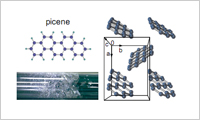Synthesis of superconducting solid picene
December 12, 2013
Source: Okayama University, Planning and Public Information Division
For immediate release: 12 December 2013
(Okayama, Japan, 12 December 2013) Research by Professor Yoshihiro Kubozono at Okayama University has potential for innovative applications of solid picene and organic superconductors, graphene and other functional materials. This research is featured in the December issue of the Okayama University eBulletin: //www.okayama-u.ac.jp/user/kouhou/ebulletin/index.html
"We are using chemistry to produce new physics," says Professor Yoshihiro Kubozono at the Department of Chemistry of Okayama University. "Our recent discovery that solid picene—a wide-bandgap semiconducting hydrocarbon—doped with potassium becomes superconducting at 7 K and 18 K is a good example because physicists are investigating the role of alkali dopants in organic compounds. We are the only group in the world focusing on superconducting picene." These results may find applications in the development of superconducting devices that dissipate extremely low energy.
Other areas of research being pursued by Kubozono and his group includes electrostatic carrier doping in two-dimensional materials such as graphene, and liquid ammonia based synthesis of metal intercalated FeSe superconductors. Electrostatic carrier doping enables the control of electrons or holes at the interface between an 'ionic liquid gate' and the underlying material—analogous to the control of carrier channels in semiconducting gated field effect transistors. "We have a wide range of activities on ionic liquid gated materials," says Kubozono. "We recently reported on why is it difficult to realize high carrier density in graphene."
Professor Kubozono is also the director of the Research Center for New Functional Materials for Energy Production, Storage and Transport at Okayama University. Launched in July 2010, researchers at the Center are taking an interdisciplinary approach for the development of science and technology for a sustainable low carbon society.
"The 13 internationally renowned scientists at the Center are making steady and significant contributions to realizing our mission," says Kubozono. "An objective view of the quality of our research can be seen by our publications in high impact journals including one paper per year in NPG Nature since the Center was launched."
The two main areas of research are the development of organic/inorganic materials for electronics and high transmission temperature organic/inorganic superconductors for the transport and storage of energy. "We are aiming to produce solar cells with efficiencies of more than 20% using non-silicon materials, and carbon-based superconductors with high transition temperatures," says Kubozono.
The research areas being investigated at the Center include:
-High efficiency organic solar cells as replacements for conventional inorganic solar cells
-High performance solar cells produced using new electronic dielectric materials
-High performance organic field effect transistor that can be manufactured by low energy consumption process
-New nanomaterials for storing hydrogen and methane
-New types of superconductors based organic materials
-Establishing materials design policy and development of superconducting materials for the realization of high temperature superconductors
-Biological system based materials for optical-energy conversion
"This research is an interdisciplinary collaboration between the researchers affiliated with this center, "explains Kubozono. "It's a process of materials synthesis, materials evaluation and device fabrication." The Center also collaborates with overseas institutes, including the University of Durham in the UK where a member of the Center is conducting experiments on the effect of pressure on the properties of superconductors. "He is our direct link with research in the EU, says Kubozono.
Funding from the 'Program for Promoting Enhanced Research Universities' (see the News section of this edition of the Okayama University e-Bulletin) will be used to invite scientists from overseas to conduct research at the Center for periods of up to three months.
Other activities planned by the Center include an annual international conference: International Workshop on Interface Science for Novel Physical Properties and Electronics. This conference will be held on 9-11 December 2013 at Okayama University.

Illustration of the structure of picene and a photograph of solid picene synthesized by Professor Yoshihiro Kubozono.
Recent publications by Professor Yoshihiro Kubozono
1. Superconductivity in alkali-metal-doped picene, Nature, 464, 76 (2010)
Fabrication of high performance / highly functional field-effect transistor devices based on [6] phenacene thin films, Physical Chemistry Chemical Physics, in press (2013).
2. Parity Effects in Few-Layer Graphene, Nano Lett., in press (2013).
3. Superconductivity in (NH3)yCs0.4FeSe, Phys. Rev. B, 88, 094521 (2013).
http://ousar.lib.okayama-u.ac.jp/metadata/51905
4. Phenanthro[1,2-b:8,7-b']dithiophene: A New Picene-type Molecule for Transistor Applications, RSC Advances, 3, 19341 (2013).
5. Electric double-layer capacitance between an ionic liquid and few-layer graphene, Sci. Rep. 3, 1595; DOI:10.1038/srep01595 (2013).
http://ousar.lib.okayama-u.ac.jp/metadata/51906
6. Correlation between energy level alignment and device performance in planar heterojunction organic photovoltaics, Organic Electronics, 14, 1 (2013).
Further information
Professor Yoshihiro Kubozono website: http://interfa.rlss.okayama-u.ac.jp/
Research Center for New Functional Materials for Energy Production, Storage and Transport website: http://www.science.okayama-u.ac.jp/RCNFM/index.html
Further information:
Okayama University
1-1-1 Tsushima-naka , Kita-ku ,
Okayama 700-8530, Japan
Planning and Public Information Division
E-mail: [email protected]
Website: //www.okayama-u.ac.jp/index_e.html
About Okayama University
Okayama University is one of the largest comprehensive universities in Japan with roots going back to the Medical Training Place sponsored by the Lord of Okayama and established in 1870. Now with 1,300 faculty and 14,000 students, the University offers courses in specialties ranging from medicine and pharmacy to humanities and physical sciences. Okayama University is located in the heart of Japan approximately 3 hours west of Tokyo by Shinkansen.
Website: //www.okayama-u.ac.jp/index_e.html